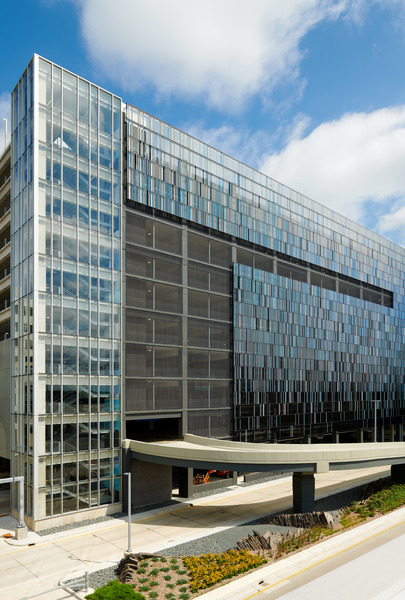 The Minneapolis-St. Paul International Airport (MSP) is the 12th busiest U.S. airport for aircraft operations, with more than 400,000 landings and takeoffs every year. The airport’s growth has significantly increased demand for additional passenger vehicle parking and amenities. The Metropolitan Airports Commission (MAC), which operates MSP, determined it was necessary to proceed with the Terminal 1 Landside Expansion Program to implement construction of the Silver Ramp, a new 5,000-stall parking structure to address customer growth.
The Minneapolis-St. Paul International Airport (MSP) is the 12th busiest U.S. airport for aircraft operations, with more than 400,000 landings and takeoffs every year. The airport’s growth has significantly increased demand for additional passenger vehicle parking and amenities. The Metropolitan Airports Commission (MAC), which operates MSP, determined it was necessary to proceed with the Terminal 1 Landside Expansion Program to implement construction of the Silver Ramp, a new 5,000-stall parking structure to address customer growth.
The MAC selected Kimley-Horn to lead this multi-year, multi-project endeavor to transform the public parking, rental car, and transit customer experience at Terminal 1. Kimley-Horn’s role included program management, project management, construction management, traffic modeling, transit design, roadway design, utility design, parking functional layout, structural design, signing and striping, landscape architecture, traffic control, phasing, program scheduling, and heavy civil cost estimating.
“The Silver Ramp project was preceded by five enabling projects that set the stage for construction of the Silver Ramp,” said program manager Ben Henderson, P.E. “The new parking ramp is highly visible to the millions of customers using the airport each year. Traveling customers will be welcomed with adequate parking, appropriately sized rental car facilities, a spacious multimodal transit center, and a beautiful, context-sensitive design.”
After reviewing many potential locations and configurations for the Silver Ramp, the preferred site placed the ramp directly above the existing Terminal 1 light rail transit (LRT) station. If unused for the parking ramp, this site would be limited in its value to MSP for other uses; therefore, it was determined that the value of building the parking ramp in this location outweighed the design and construction cost to implement a technically challenging solution. The Kimley-Horn team assessed feasibility by conducting 3D geostructural analyses of the LRT station. Models were created and calibrated using rock properties, joint mapping, and rock movement information initially collected during the station construction in 2002. The team concluded that the project would need to incorporate large transfer beams to carry the high column loads for the Silver Ramp to the sandstone layer behind the perimeter walls of the LRT station. The design resulted in the team implementing cast-in-place post-tensioned concrete transfer beams ranging in size from 5- to 15-feet wide, 8- to 13-feet deep, and 50- to 90-feet long.
“To serve the needs of airline customers and airport tenants, airport operations could not be shut down. explained project manager Jerry Schwientek, P.E. “The program required extensive forward-thinking and a deep understanding of operations to keep the airport running at all times to meet the 20-month construction schedule. Each decision on scope and construction sequence considered utility phasing, impacts to airport operations, design schedules, and construction schedules. The holistic plan was reviewed with airport stakeholders to ensure it was consistent with operational requirements and to inform them of when operations would be impacted.”
Significant scope elements of the Silver Ramp project included 10 structured levels of parking, 13-story core building, eight load transfer beams, mass rock excavation, LRT ventilation shaft relocation, an underground pedestrian walkway, a rental car agency customer service building, bus and shuttle transit center, secured fire access lane, hardscape and landscape design, and a pet relief station. In addition, the Silver Ramp provides approximately 2.1 million square feet of structured parking, including 3 miles of expansion joints, 5 acres of exterior façade, and 180,000 square feet of conditioned floor space.
